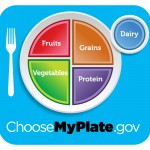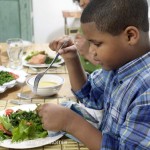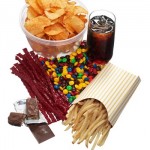healthy kids & families
Nutrition for School-Aged Children

Eating becomes a social activity in this stage of life. Your kids may spend more time in school than they do at home, eat meals at friends’ houses, and adopt eating habits from their peers. It can be difficult to ensure they are getting adequate nutrition when you are not around to monitor their choices, so try to maintain regular family mealtimes.
Nutrition guidelines for school-age kids
As children develop, they require the same healthy foods adults eat, along with more vitamins and minerals to support growing bodies. This means whole grains (whole wheat, oats, barley, rice, millet, quinoa); a wide variety of fresh fruits and vegetables; calcium for growing bones (milk, yogurt, or substitutes if lactose intolerant); and healthy proteins (fish, eggs, poultry, lean meat, nuts, and seeds). For kids aged 5-12, the key word is variety. Creative serving ideas will go a long way towards maintaining healthy eating habits.
 Vegetables
Vegetables
3-5 servings per day. A serving might be one cup of raw leafy vegetables, 3/4 cup of vegetable juice, or 1/2 cup of other vegetables, raw or cooked.
Fruits
2-4 servings per day. A serving may consist of 1/2 cup of sliced fruit, 3/4 cup of fruit juice, or a medium-size whole fruit, such as an apple, banana or pear.
Whole Grains
6-11 servings per day. Each serving should equal one slice of whole grain bread (beware of breads with only “wheat” versus “whole wheat/ whole grain”, 1/2 cup of rice or 1 ounce of whole grain cereal (stay away from the high sugar cereals).
Protein
2-3 servings of 2-3 ounces of cooked lean meat, poultry, or fish per day. A serving in this group may also consist of 1/2 cup of cooked dry beans, one egg, or 2 tablespoons of peanut butter for each ounce of lean meat.
Dairy products
2-3 servings (cups) per day of low-fat milk or yogurt, or natural cheese (1.5 ounces=one serving).
Zinc
Studies indicate that zinc may improve memory and school performance, especially in boys. Good sources of zinc are oysters, beef, pork, liver, dried beans and peas, whole grains, fortified cereals, nuts, milk, cocoa, and poultry.
Water
6-8 glasses each day.
Healthy fat
Healthy fats are also important to a child’s development. These include monounsaturated fats from plant oils like canola oil, peanut oil, and olive oil, as well as avocados, nuts (like almonds, hazelnuts, and pecans), and seeds (such as pumpkin, sesame; and polyunsaturated fats, including Omega-3 and Omega-6 fatty acids, found in fatty fish, such as salmon, herring, mackerel, anchovies, and sardines, or in unheated sunflower, corn, soybean, and flaxseed oils, and walnuts. Read more on our Healthy Fats page.
Healthy Habits for Life
 The Importance of Family Meal Time
The Importance of Family Meal Time
Not only do family meals provide an opportunity to catch up on your kids’ daily lives, they also enable you to “teach by example.” Let your kids see you eating a wide variety of healthy foods while keeping your portions in check. Refrain from obsessive calorie counting, though, or commenting on your own weight, so that kids don’t adopt negative associations with food.
School Lunches
Approximately one third of the food children consume is at school. For this reason, it is important that children have a daily balanced diet, either through packed healthy snacks and lunches or through a healthy meal plan. Unfortunately, many schools continue to offer lunches that are heavy in processed and high sugar foods and drink. Encourage your child’s school and school district to offer fresh daily produce and eliminate sugary treats (such as flavored milk, desserts, ice cream treat) as part of the meal plan, school celebrations and fundraisers. See our Healthy Schools pages to learn more.
Rethink Your Child’s Drink
 Kids are drinking more soda and sugary beverages (including sugar loaded juices) than ever before — drinks that contribute to obesity risk, dental health problems and poor nutrition. The best bet continues to be water. If your children regularly drink soft drinks, they have a greater risk for a number of health problems, including weaker bones. Many kids consume far too much of these unhealthy drinks when they should be drinking water as their primary beverage. As well as this, when young people consume soft drinks they tend to drink less milk and this means that they may not get enough calcium. This is an important issue during childhood and adolescence, which is a key time for bone growth and development. Now is the time to reset your child’s drink habits and make water central. Read more on our Rethink Your Child’s Drink page.
Kids are drinking more soda and sugary beverages (including sugar loaded juices) than ever before — drinks that contribute to obesity risk, dental health problems and poor nutrition. The best bet continues to be water. If your children regularly drink soft drinks, they have a greater risk for a number of health problems, including weaker bones. Many kids consume far too much of these unhealthy drinks when they should be drinking water as their primary beverage. As well as this, when young people consume soft drinks they tend to drink less milk and this means that they may not get enough calcium. This is an important issue during childhood and adolescence, which is a key time for bone growth and development. Now is the time to reset your child’s drink habits and make water central. Read more on our Rethink Your Child’s Drink page.
Eating out with kids: fast food and restaurant nutrition
Fast food companies speak to children early, often, and when parents are not looking. Fast food is the most unhealthy food product marketed to children, other than sugar-sweetened beverages, and is relentlessly and aggressively targeted toward children starting as young as age two. Food marketing to children negatively influences the dietary choices and health of society’s most vulnerable citizens. Given the childhood obesity epidemic at hand, we need both educate and lead our children to make healthy meal choice, both in our kitchen and while eating out.
It might be challenging to persuade your children to order a salad instead of a cheeseburger, but you can steer them towards healthier options. Some important tips to remember about fast food and restaurant dining for kids:
- Avoid sodas – Kids should drink water or milk instead.
- Avoid chicken nuggets – Unhealthy imposters of real chicken.
- Skip the fries – Consider taking along a bag of mini carrots, grapes, or other fruits and vegetables to have instead. This will add vitamins and fiber to the meal.
- If you order the kid’s meal, ask for some substitutions – substitute healthier choices for the soda and the fries if possible.
- Opt for chicken and vegetables or spaghetti with tomato sauce in a sit-down restaurant, rather than a big plate of macaroni and cheese, which is heavy is fat and salt and often offers little nutritional value.
 Kids, like the rest of us, should limit:
Kids, like the rest of us, should limit:
Trans fats, found in vegetable shortenings, some margarines, crackers, candies, cookies, snack foods, fried foods, baked goods, and other processed foods made with partially hydrogenated vegetable oils. See our Sugar and Kid’s Health page for more information.
Sources: HELPGUIDE.ORG in collaboration with Harvard Nutrition Publications and Yale Rudd Center for Food Policy and Obesity

